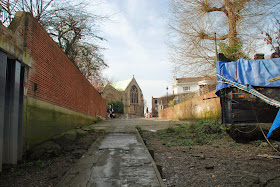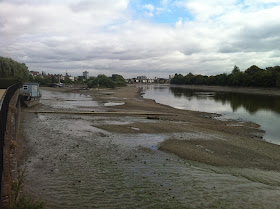I heard a story the other day that sent a shiver down my spine.
You see it all kicked off a long time ago; way back in 1888 to be precise.
The autumn of that year was particularly terrible for the poor women who lived in the impoverished district of Whitechapel in London's East End. There'd been a lot of immigration into the area from Ireland as people fled the famines, and from Russia as Jewish families fled the Tsar's pogroms. There was chronic over-crowding: lots of people crammed in together who came from different backgrounds and cultures and didn't understand one another. No one had any money. Crime was rife. Large numbers of women had been abandoned and fell into lives of vice. It wasn't a happy place. And then, when they were no doubt thinking that things couldn't get a whole lot worse, a mass murderer emerged from the shadows, a sadistic, evil individual who preyed on women who were out on their own.
They nicknamed him Jack the Ripper. In a matter of weeks five women in succession were found with their throats slashed. Four of them had been horribly mutilated after death, and their injuries suggested that their assailant may have been familiar with the study of human anatomy.
The nightmare started on 31st August, 1888 with the death of Mary Ann Nichols, a 43 year-old mother of five, deserted by her husband and who, because of her alcoholism, hadn't been able to pay the fourpence necessary to bed down in her usual lodging house that night. The killing spree claimed three more victims before ending abruptly on 9th November with the murder of Mary Jane Kelly, a pretty, buxom girl of about 25 who may originally have been Irish and who was known to be fluent in Welsh. Poor Mary Jane's family were never traced, and were never to find out what had become of their lost daughter.
And then ... nothing.
No more murders took place to match the modus operandi of the five Whitechapel killings. No one was ever caught. London held its breath ... and wondered what had happened. Conspiracy theories abounded. Had it been the handiwork of Queen Victoria's grandson, the Duke of Clarence? Were the Freemasons to blame? What about Lewis Carroll, creator of Alice in Wonderland or Walter Sickert, the artist? No one was above suspicion.
The ensuing police investigation was extensive. The newspaper men watched closely and relayed every twist and turn to an enthralled public. Experts were called in from all corners, but Jack the Ripper was never apprehended.
No more murders took place to match the modus operandi of the five Whitechapel killings. No one was ever caught. London held its breath ... and wondered what had happened. Conspiracy theories abounded. Had it been the handiwork of Queen Victoria's grandson, the Duke of Clarence? Were the Freemasons to blame? What about Lewis Carroll, creator of Alice in Wonderland or Walter Sickert, the artist? No one was above suspicion.
The ensuing police investigation was extensive. The newspaper men watched closely and relayed every twist and turn to an enthralled public. Experts were called in from all corners, but Jack the Ripper was never apprehended.
One of the suspects was a barrister called Montague John Druitt, but the evidence linking him to the crime was circumstantial. On 30th December, 1888 his body was spotted floating, face down in the water off Chiswick Causeway. Henry Winslade, a waterman, pulled him out of the water, dragging the remains onto the causeway, which at that time was used by John Thorneycroft's torpedo boatyard to launch their boats.
 |
| Chiswick Causeway |
Druitt's pockets had been weighed down with stones, which had kept the body submerged in the Thames for about a month. They also contained a return train ticket to Hammersmith station dated 1st December, 1888, a handsome silver watch, a cheque for £50 and £16 in gold sovereigns. No one knew why he was carrying so many valuables with him at the time of his death, although there was speculation that he may have been paying off a blackmailer, which, in turn, made people wonder what dark secret he might have taken with him to his grave.
Whatever the way of it, the killings stopped, and rumours started to circulate about Jack the Ripper. They claimed that he had been the son of a surgeon, and that he had committed suicide. They said his body had been found in the Thames. The source of these rumours was never clear, but in a private memorandum written by Sir Melville MacNaughten, the Assistant Chief Constable, Druitt was named as a suspect. MacNaughten claimed to have unspecified private information that left little doubt Druitt's own family believed him to have been the murderer.
Much has since been made of the timing of Druitt's death so very shortly after the murders ended, and of the fact that Druitt's father was a surgeon from whom he may have learnt the rudiments of dissection and anatomy. His rooms in the Inner Temple were also reasonably close to Whitechapel.
An inquest was held into Druitt's death, which established that there had been an extensive history of mental illness in his family and returned a verdict of suicide, committed whilst he was of unsound mind. This, in turn, was duly seized upon as further evidence that he was guilty: only a mad man could have killed and mutilated his victims in the way Jack the Ripper had done.
 |
Chiswick Causeway at low tide
|
And, having said all that, I really can't go sounding too superior as though I'm somehow above all this whodunnit business. It's pretty obvious I've been sucked in too given how excited I was at the notion that Jack might have washed up on one of my favourite dog walks.
All the best,
Bonny x
As shared on Friday Finds


That story has always fascinated me. Great photos.
ReplyDeleteThanks, Sarah. It kind of fascinates me and haunts me all at the same time. All the best, Bonny
DeleteThe mystery of Jack will always keep people guessing I suppose we will never really know ...
ReplyDeleteI suspect you're right: I doubt we'll ever find out who Jack really was. All the best, Bonny
DeleteIt is a story that seems to captive all of our attention. Your photos were wonderful.
ReplyDeleteThank you, Diane. All the best, Bonny
Delete